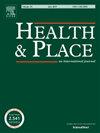Spatial and socioeconomic disparities in the availability of healthy food via online food delivery services in Nanjing, China: An analysis based on absolute and relative measures
IF 4.1
2区 医学
Q1 PUBLIC, ENVIRONMENTAL & OCCUPATIONAL HEALTH
引用次数: 0
Abstract
As part of the urban food environment, online food delivery services (OFDS) have expanded the channels and options for residents to access food. While it may be seen as a way to improve food access, there is widespread debate over whether it can provide healthy food options for residents. Existing studies have primarily measured the absolute indicators of healthy food supply through OFDS, but have lacked comparative analyses of absolute and relative indicators. The spatial and socioeconomic disparities in the supply of healthy food through OFDS remain to be further explored. This study seeks to address this question through a case study of Nanjing. The findings indicate significant spatial differences in the characteristics of healthy food delivery availability when comparing relative and absolute metrics. For communities in central areas, both absolute healthy and unhealthy food delivery outlets form high-high clusters, but the relative proportion and diversity of healthy food outlets fall into low-low clusters. This contrasts with the spatial characteristics observed in peripheral communities, where both relative and absolute metrics of healthy food delivery availability show opposite patterns. Additionally, communities with lower housing prices, larger working populations, and higher proportions of young or older residents have relatively fewer opportunities to access healthy food delivery outlets. Our findings suggest that differentiated community-based strategies and platform-level interventions are essential to improve healthy food access and diversity via OFDS.
南京市在线外卖服务中健康食品可得性的空间和社会经济差异:基于绝对和相对度量的分析
作为城市食品环境的一部分,在线食品配送服务(OFDS)扩大了居民获取食品的渠道和选择。虽然这可能被视为改善食物获取的一种方式,但对于它是否能为居民提供健康的食物选择,人们存在广泛的争论。现有研究主要通过OFDS测量健康食品供应的绝对指标,但缺乏绝对指标和相对指标的比较分析。通过OFDS提供健康食品的空间和社会经济差异仍有待进一步探讨。本研究试图通过对南京的个案研究来解决这一问题。研究结果表明,在比较相对和绝对指标时,健康食品配送可得性的特征存在显著的空间差异。对于中心区域的社区,绝对健康和不健康外卖网点均呈高-高集群,而健康餐饮网点的相对比例和多样性呈低-低集群。这与在周边社区观察到的空间特征形成对比,在那里,健康食品供应的相对和绝对指标都显示出相反的模式。此外,在房价较低、工作人口较多、年轻或老年居民比例较高的社区,获得健康食品外卖的机会相对较少。我们的研究结果表明,差异化的社区策略和平台级干预措施对于通过OFDS改善健康食品的获取和多样性至关重要。
本文章由计算机程序翻译,如有差异,请以英文原文为准。
求助全文
约1分钟内获得全文
求助全文
来源期刊

Health & Place
PUBLIC, ENVIRONMENTAL & OCCUPATIONAL HEALTH-
CiteScore
7.70
自引率
6.20%
发文量
176
审稿时长
29 days
期刊介绍:
he journal is an interdisciplinary journal dedicated to the study of all aspects of health and health care in which place or location matters.
 求助内容:
求助内容: 应助结果提醒方式:
应助结果提醒方式:


